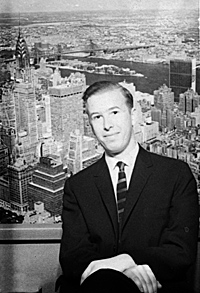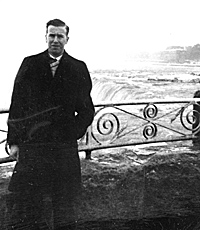 Playing tourist in New York, 1961.
Playing tourist in New York, 1961.
Thanks are due to the Society of Young Publishers for my first visit, forty years ago, to the United States. In 1961 they secured funding for two of their members to go to New York. Applicants were to send in a paper setting down why they wanted to go (a silly question: New York was seen as the most exciting and glamorous place on the planet) and to be interviewed. Yes, I really, really wanted to go. No, I was not chosen.
At Herbert Jenkins they had supported my application. I think that there had been only two post-war visits by Derek Grimsdick to New York, but he and his colleagues decided that there should be another visit by a representative of the company. Spurred by the desire I had shown to go under the aegis of the Society for Young Publishers, they decided that I should go.
So it was that in October 1961 I flew off (in a plane with propellers) to New York for three weeks. I stayed at a very large, low cost hotel far over in West 58th. I only stayed there the once, because the hotel was far from the centre and the area inevitably went into decline, the hotel closing.
I knew no-one at that time over there, and it could be very lonely. I was very busy during the daytime, but it was awfully quiet in the evenings and at the weekends, with nobody to talk to. Hence one of the things I did was to play tourist and do such things as take the Circle Line cruise around Manhattan, go up the Empire State Building, visit the United Nations Building and so forth. New York bus and subway fares at that time were fifteen cents, and I believe that subway tokens would have been a great investment, if only one could have stock-piled them, for nowadays they cost $1.50. I also ate at the local Horn and Hardart; a Woolworths-style cafeteria with a bank of glass boxes from which one's meal could be selected (I eat rather differently nowadays).
Every day I wrote a letter reporting on my activities, addressing it 'Dear Mr Grimsdick and Dear Mr Eagle' (this being after I had already worked with them for five years). Reviewing these, I see that I wrote forty pages with daily detail, packing into the three weeks meetings with 105 people at ninety publishing houses. But how the publishing scene changed over the years, on both sides of the Atlantic. Amongst the firms I visited were houses which were well-known and innovative back then, but are now long since out of business and forgotten. These include:
- Fleet Publishing
Ronald Press
Thomas Yoseloff/A. S. Barnes
Duell, Sloan & Pearce
Ivan Obolensky
Julian Press
Hearthside Press
Grosset & Dunlop
Fawcett
Hastings House
Hill and Wang
Julian Messner
Orion Press
Philosophical Press
Channel Press
University Press
Devin-Adair
Bernard Geis
Frederick Fell
Rudo Globus
Tudor
Hearthside Press offered us the first cookery book which was based on a novel slimming regime, but we turned this down. Who in Britain had ever heard of Weight Watchers, and such a slimming plan could never work for our sort of audience, could it? It was whilst, however, I was talking to the husband-and-wife team who ran Hearthside Press that they mentioned the forthcoming Hallowe'en evening. At that time Hallowe'en was little known in Great Britain, and there was certainly no concept of children going around to play 'Trick or Treat'. It is only over subsequent years, following many American films and television programmes, that Hallowe'en has become part of British culture. So I went to their home at Long Island, for dinner and to go 'Trick or Treating' with their children. People thought I had a wonderful disguise as an English gentleman.
The timing of my visit was, with the benefit of hindsight, most fortunate in being at the beginning of the great days of co-edition sales from British publishers to the United States, which also sparked a number of return deals. The heyday of the co-edition lasted through the sixties and seventies, but faltered shortly afterwards, due to changing business patterns. However, a small number of publishers still do co-edition business.
One of the people I met with at that time was Milton Gladstone of Arco. In my daily letter back home I reported:
"3.00. ARCO. Saw Milton Gladstone. Had a very interesting conversation with this man which I think should be most fruitful. He expressed interest in a number of our books and I am returning to his office on Monday to continue our talk and to see his books."
This contact led to many years of friendship, and mutual good business. Arco bought co-editions of all the Herbert Jenkins’ books on firearms, and were subsequently remarkably supportive when I came to undertake publishing at Arms & Armour Press. Arco for many years were probably one of the largest American importers of British co-editions, on a wide range of non-fiction subjects.
The results of all of the many, many meetings I had, and relationships I established, created a worthwhile number of transactions, with books being added to the Herbert Jenkins list and books sold to U.S. publishers. Hence I went over again in 1963 and now see that my letters at that time were addressed to: 'Dear Mr Grimsdick' and some separately to 'Dear Mr Eagle'. I had by then been working with them for seven years.
 This trip was for a longer period of time - a month - and also took in a couple of days in Toronto, via the Niagara Falls (at right) on a freezing, viciously cold day.
This trip was for a longer period of time - a month - and also took in a couple of days in Toronto, via the Niagara Falls (at right) on a freezing, viciously cold day.
Again I was extremely active in getting around as much as I could, because the Herbert Jenkins’ list was of a very wide and general nature and there were many, many publishers to discuss books with. Where books on military history and firearms however were concerned, I see from my correspondence the pursuit of quite a number of such and a meeting on 17th April 1963:
"FOLLETT. Discussed our distribution of Gun Digest and their other books on firearms. Will be speaking to them again."
Herbert Jenkins did subsequently undertake such distribution, and my relationship with Gun Digest has continued over the years, as Follett sold the list to a new, stand-alone company which became known as DBI Books Inc, and as that list was more recently sold to Krause of Iola, Wisconsin.
Another relationship which continues to the present was with Stackpole Books and on Monday 29th April I reported:
“STACKPOLE. Had a long talk with their Sales Director. I think that we will now be able to take their titles on a really exclusive basis. Possibilities that they may be interested in taking some of our future books but these are slight.”
In the early 1960s it was really special to go to New York. New York had yet to be invaded by the British, and for many people their only familiarity with the English accent was from films or David Frost, and I probably could have used his name to sign bills in restaurants etc. for I was frequently asked if I was him. The accent also had a great effect on young ladies. From the British viewpoint, it was so unusual to be able to go to New York that one's views of America and opinion of American society were eagerly sought. The British perception of the United States in general, and of New York in particular, was likewise from films and television, and this gave it a glamour which, for a period, I was very happy to have rub off a little on me. My first visit coincided with JFK being President. Those were the days of Camelot (both on the stage, but also with JFK’s glamorous wife in Washington DC).
One characteristic of New York is the afternoon change of shift by taxi cab drivers. Woe betide if you are trying to catch a taxi at that time. One time I was trying to catch a taxi at 4pm from downtown at 20th Street to get uptown to 50th Street, much too far to walk, and was somewhat anxious and already late for a meeting. All of the taxis zoomed past with their 'Off Duty' signs alight, and I started to indicate that I wanted to go in their direction heading off duty, by standing in the middle of the road and thumbing a lift and pointing at myself. A taxi stopped and said that he would take me part of the way. I jumped in and endeavoured to get better service from the driver by starting a conversation. Encouraging the driver to talk, reckoning that the longer that he talked the closer to the destination he would take me, it was soon revealed that the taxi driver had served in the British Army for twelve years. Where? Mainly with the 51st Highland Division, especially in North Africa and Italy. There was a discussion about Rommel (which I based on publishing books such as Rommel: Battles and Campaigns by Kenneth Macksey and Rommel's own Infantry Attacks) and it turned out that the driver had, he claimed, participated in the abortive Long Range Desert Group raid to kill Rommel. How about tanks? The driver had seen service in Valentines and Matildas, and so a copy of British Military Tanks and Markings and Names was pulled from my brief case and shown him. At each intersection and traffic jam, gradually progressing in the required direction, the driver looked through the book and expressed delight at seeing the tanks that he remembered so well. 'Where can I obtain a copy of this book?' he asked. The answer, as we finally arrived at the required address, was immediately 'with the compliments of the publisher'.
Forty years on, New York is still stimulating and exciting, and one can feel the electricity in the streets. Physically, in fact, New York has changed little over the years, and although there have been new skyscrapers built, one tall building looks very much like another. Thus the only real change to the basic profile of the city was when the new PanAm building blocked the vista of Park Avenue. Forty years on, even the hotel I stayed in on my first visit has been resurrected and become the fashionable Ian Schrager, Philippe Starck-designed fashionable Hudson.
Yet it was those early visits to New York that made me realise what London meant to me, and London's human scale. It is in fact London which has become more exciting over the years, evolving into a twenty-four hour city which is hot with activity and cool with style, and dynamic with a never-ending stream of new buildings, restaurants and cultural activity.
Back to Greenhill Military Book News No. 107 Table of Contents
Back to Greenhill Military Book News List of Issues
Back to Master Magazine List
© Copyright 2001 by Greenhill Books
This article appears in MagWeb (Magazine Web) on the Internet World Wide Web.
Other military history articles and gaming articles are available at http://www.magweb.com